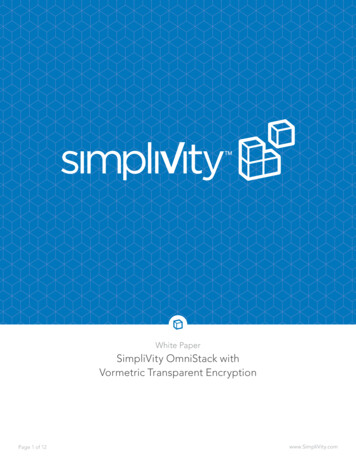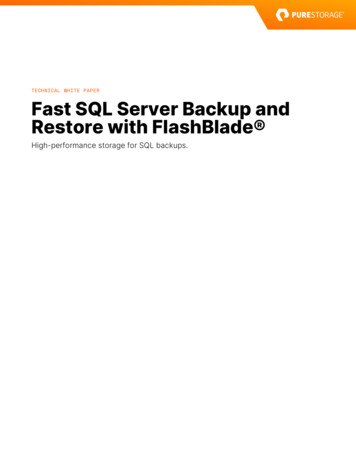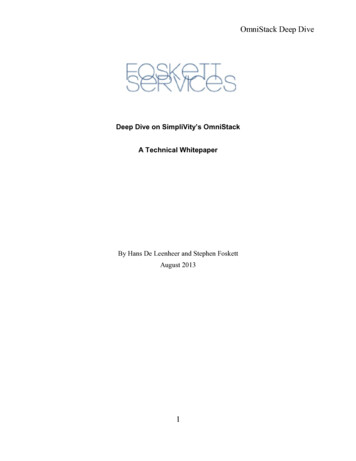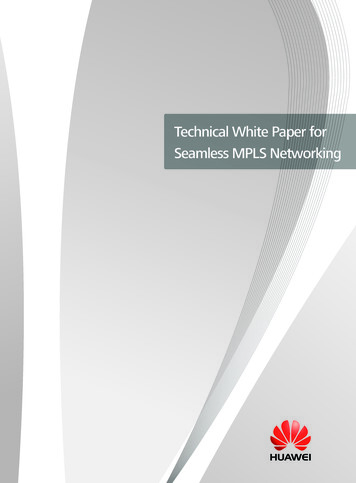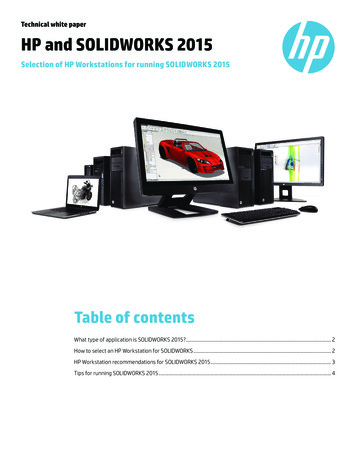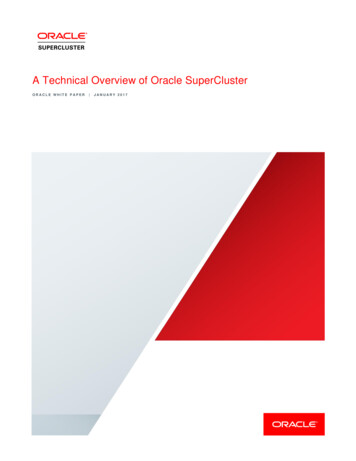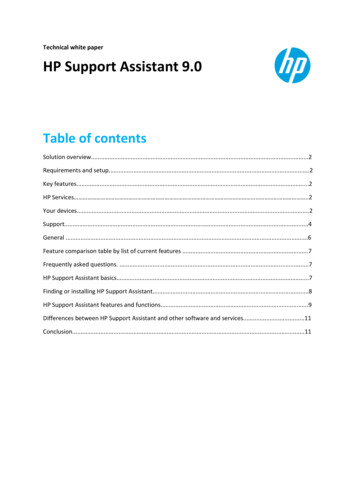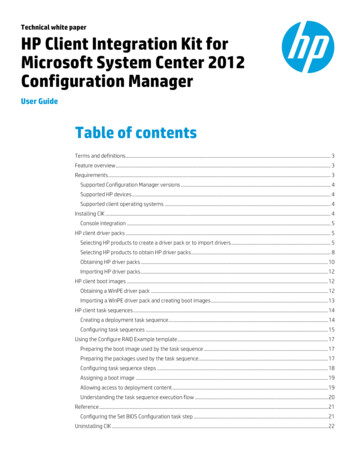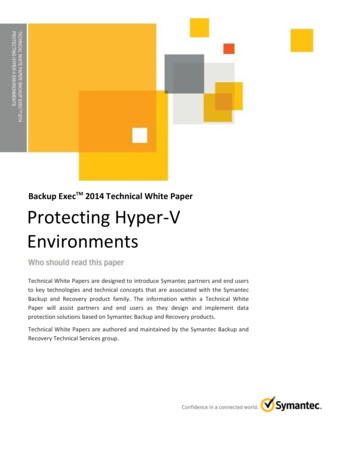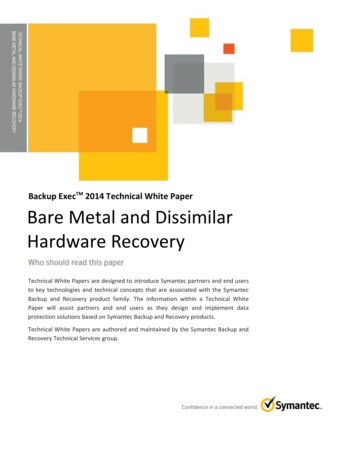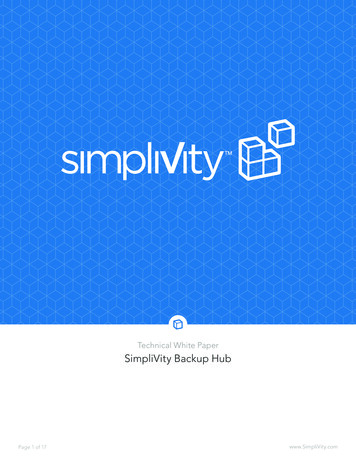
Transcription
Technical White PaperSimpliVity Backup HubPage 1 of 17www.SimpliVity.com
Technical White PaperTable Of ContentsExecutive Summary 3Purpose 3Audience 3Introduction 4Why Simplivity?. 4Simplivity Technology Overview And Key Features. 5Solution Overview 6Project Hub Models.7Value Proposition.7Deployment Options 7Add Backup Hub To An Existing SimpliVity Deployment.7Add Backup Hub To A New SimpliVity Deployment. 8Use Cases For Backup Hub. 8Use Case 1 – Backup And Restore. 8Architecture. 8How To: Backup And Restore Data. 9Policy-Based Backup. 9Manual Backup. 9Restoring A VM. 10Use Case 2 – Moving Backups To Tape Library.11Architecture.11How To: Archive VMs To Tape.11Planning And Sizing 11Backup Considerations.11Backup Frequencies.11Backup Retention.12Change Rate.12VM Size.12Backup Scheduling.12Latency.12Calculation Formula.12Examples 12Example 1:.12Example 2:. 13Example 3. 13Example 4:. 14Example 5:.15Best Practices And Recommendations.15VM Size 15Pre-Seed Backup Hub.15Schedule Backups.15Monitor Performance.15Backup Size And WAN Bandwidth.15Backup Policies.16Multi-Level Backups.16Independent DR Solution.16Summary/Conclusion 17Page 2 of 17www.SimpliVity.com
Technical White PaperExecutive SummaryThis paper documents technical information on SimpliVity’s Backup Hub offering along with the benefits it provides interms of longer retention of data, improved RPO’s and basic operational efficiency. Backup methodologies, use cases andbest practices are also detailed in this paper.PurposeThe purpose of this paper is to introduce the reader to SimpliVity’s Backup Hub offering. It discusses deployment optionsand use cases for the Backup Hub within a SimpliVity environment. Best practices and recommendations for backing updata is also covered in this paper.AudienceThe audience for this paper are customers, IT professionals who want to learn about the Backup Hub product offering andwant to deploy it within their data centers.Page 3 of 17www.SimpliVity.com
Technical White PaperIntroductionAcquiring, implementing and managing affordable backup storage for growing VM volumes, onsite and off-site, continuesto be a challenge for enterprise data centers today.A well-established data center strategy for reducing enterprise recovery point objectives (RPO) is to backup data morefrequently. But even in highly virtualized environments, storing larger quantities of operational backups can be costly,depending on the size of the VMs, how much they change, and how often they are backed up. In order to meet increasingly stringent RPOs, enterprises that back up their data more frequently are seeking cost effective storage solutions fortheir growing volume of operational VM backups.In addition, global enterprises today face a growing and ever-changing landscape of country-level and industry specificregulations associated with data retention and protection. Keeping data for longer periods helps organizations complywith a wider range of government regulations, but requires more backup storage, which again, can be costly. Enterprisestoday are looking for ways to cost-effectively migrate and store their operational backups at both local and offsite storagelocations, to support longer data retention and backup aging policies that help them comply with expanded regulationsfor data retention and protectionWhy SimpliVity?SimpliVity’s hyperconverged infrastructure solution transforms the data center by virtualizing data and incorporating allIT infrastructure and services below the hypervisor into commodity x86 building blocks. With 3X total cost of ownership(TCO) reduction, SimpliVity provides software-defined hyperconverged infrastructure delivers the best of both worlds: theenterprise-class performance, protection and resiliency that today’s organizations require, with the cloud economics businesses demand.Designed to work with any hypervisor or industry-standard x86 server platform, the SimpliVity solution provides a single,shared resource pool across the entire IT stack, eliminating point products and inefficient siloed IT architectures. The solution is distinguished from other converged infrastructure solutions by three unique attributes: accelerated data efficiency,built-in data protection functionality and global unified management capabilities. Accelerated Data Efficiency: Performs inline data deduplication, compression and optimization on all data at inceptionacross all phases of the data lifecycle, all handled with fine data granularity of just 4KB-8KB. On average, SimpliVity customers achieve 40:1 data efficiency while simultaneously increasing application performance. Built-In Data Protection: Includes native data protection functionality, enabling business continuity and disaster recovery for critical applications and data, while eliminating the need for special-purpose backup and recovery hardware orsoftware. OmniStack’s inherent data efficiencies minimize I/O and WAN traffic, reducing backup and restore times fromhours to minutes. Global Unified Management: A VM-centric approach to management that eliminates manually intensive, error-proneadministrative tasks. System administrators are no longer required to manage LUNs and volumes; instead, they canmanage all resources and workloads centrally, using familiar interfaces such as VMware vCenter and VMware vRealizeAutomation.The SimpliVity solution includes its OmniStack software and related technologies, packaged on popular x86 platforms—either on 2U servers marketed as SimpliVity OmniCube, or with partner systems from Cisco or Lenovo, marketed as OmniStack with Cisco UCS and OmniStack with Lenovo System x, respectively.Page 4 of 17www.SimpliVity.com
Technical White PaperAn individual OmniStack node includes: A compact hardware platform - a 2U industry-standard virtualized x86 platform containing compute, memory, performance-optimized SSDs and capacity-optimized HDDs protected in hardware RAID configurations, and 10GbE networkinterfaces. A hypervisor such as VMware vSphere/ESXi. OmniStack virtual controller software running on the hypervisor. An OmniStack Accelerator Card – a special-purpose PCIe card with an FPGA, flash, and DRAM, protected with supercapacitors; the accelerator card offloads CPU-intensive functions such as data compression, deduplication and optimization from the x86 processors.(4) Servers & VMwareStorage Switch(2) HA shared storageBackup & DedupeOne Building Block3x TCO Savings Global Unified Management Operational Efficiency WAN Optimization Cloud GatewaySSD ArrayStorage CachingData Protection ApplicationData Protection AppsEnterpriseCapabilitiesData ProtectionApplicationCloudEconomicsFigure 1 – Legacy ComparisonSimpliVity Technology Overview and Key FeaturesOmniStack was specifically designed to meet the stringent price-performance, scalability, agility and resiliency demandsof today’s data-intensive, highly virtualized IT environments. Key benefits and advantages include: Superior economics: OmniStack eliminates infrastructure cost and complexity by consolidating a variety of IT functions (compute, storage, network switching, replication, backup, etc.) onto commodity virtualized x86 hardware, withglobal unified management. The solution contains CAPEX by eliminating IT silos, converging technology stacks, andoptimizing storage capacity; and it reduces OPEX by containing power, cooling, rack space and system administrationexpenses. Linear scalability: The SimpliVity solution features a scale-out architecture that minimizes upfront investments and provides a high degree of flexibility and extensibility. OmniStack nodes are installed in an incremental fashion to accom-Page 5 of 17www.SimpliVity.com
Technical White Papermodate growth, enable new applications or extend system availability. Two or more OmniStack nodes can be federatedto create a massively scalable pool of shared resources that is administered as a cohesive system, with a single administrative interface. VM-centric design: OmniStack was designed from the ground up with virtualization in mind. The solution abstracts datafrom the underlying hardware; virtual machine files are mapped directly to blocks on storage. All data storage, management, and protection functions are inherently optimized for virtualization. And all administrative tasks—including managing data protection policies, analyzing performance and troubleshooting problems—are performed at the VM level.From an administrative perspective, a datastore is simply a logical construct, decoupled from the underlying physicalinfrastructure. Concepts like LUNs, volumes, shares, and disk groups simply don’t apply with SimpliVity. Accelerated IT service agility: OmniStack’s inherent data efficiencies and VM-centric management capabilities dramatically simplify operations and boost IT service agility. With OmniStack, system administrators can spin up IT services andclone VMs in just seconds with two or three mouse clicks. High resiliency: The SimpliVity solution is designed to be highly resilient, with no single point of failure. The solutionsupports both RAID (redundant array of independent disks) for disk-level resiliency and RAIN (redundant array of independent nodes) for node-level resiliency. In a high availability RAIN implementation, the complete set of data associated with a VM is simultaneously written to two distinct nodes, protecting data in the event of disk or node failures.Public CloudFigure 2 – An OmniStack FederationSolution OverviewDesigned and optimized for SimpliVity hyperconverged infrastructure, the Backup Hub provides extra-large operationalstorage capacity that’s affordable, efficient, and easy to implement and manage.SimpliVity’s Backup Hub is specifically configured and affordably priced for operational VM backup storage. Its highly efficient OmniStack Data Virtualization Platform maximizes the number of VM backups that can be safely stored in a data center rack. The Backup Hub also supports most third-party tape backup solutions, for archiving VM backups to cold storage.SimpliVity’s Backup Hub is automatically detected, recognized and registered when connected to a SimpliVity Federation.It can be managed with the same VM-centric tools that are used to manage your overall SimpliVity hyperconverged infrastructure.Page 6 of 17www.SimpliVity.com
Technical White PaperBackup and Restore technologyData protection is fully integrated into SimpliVity’s hyperconverged offering and architected into its technological foundation, eliminating the need for purpose-built backup/recovery and disaster recovery applications and appliances. Management of backup policies is performed at the VM-level, with just a few clicks, and fully managed within VMware vCenter.All backups and restores are full logical copies of VMs with negligible impact on running applications. SimpliVity reducesdowntime with its ability to restore Terabyte (TB) VMs in seconds, with backups as frequently as every 10 minutes.For SimpliVity enterprise customers that want affordable storage for their growing operational VM backup requirements,the Backup Hub delivers extremely efficient, easily implemented and highly
either on 2U servers marketed as SimpliVity OmniCube, or with partner systems from Cisco or Lenovo, marketed as Omni - Stack with Cisco UCS and OmniStack with Lenovo System x, respectively. . Cost effectively and efficiently support increased backup frequencies that improve your RPOs
